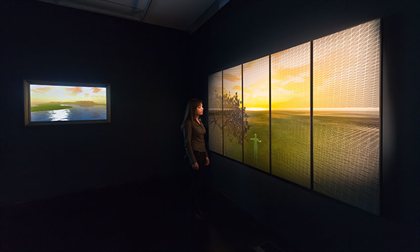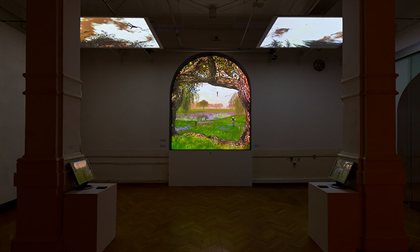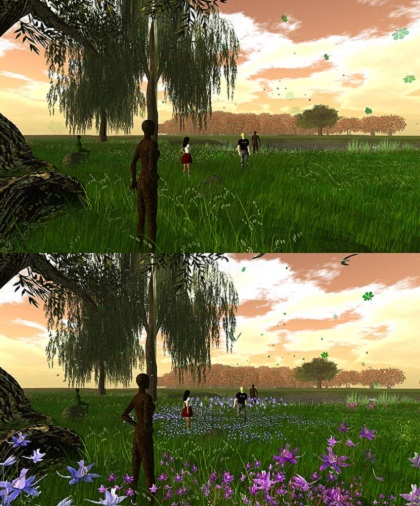Mobility to Immersion
This project explored how the potentialities of mobile devices can be meaningfully integrated as core components within complex, digitally-hybrid environments to extend or redefine traditional spectator experiences.
Mobility to Immersion was a project led by Michael Takeo Magruder (takeo.org) from the Department of Digital Humanities at King's, in collaboration with the National Theatre and body>data>space as part of their Robots & Avatars exhibition. Using the 'Visions of Our Communal Dreams' art commission in the exhibition as an experimental testbed, the project explored the development, application and assessment of creative and technical frameworks through which users of mobile devices could both influence and be influenced by digitally-enabled cultural activities within public spaces.

Visions of Our Communal Dreams v1.0 by Michael Takeo Magruder with Drew Baker, ErikFleming & David Steele, 2012. One of the artwork’s many site-specific installations at FACT, Liverpool as part of the Robots & Avatars exhibition
Although mobile devices have been successfully used to augment (or sometimes even replace) traditional mechanisms for disseminating information and visitor resources surrounding public exhibitions and performances, little work has been done in incorporating these systems as core elements within multi-faceted, digitally-based cultural experiences in the 'real' world. Over an eighteen-month period, an interdisciplinary team of artists, academics and technologists undertook a practice-led programme of collaborative research and development focusing on questions such as:
- What kinds of additional and meaningful layers of visitor interaction become possible through the facilities offered by the latest generation of smartphones and tablets?
- How can the socially-immersive qualities of these mobile devices be effectively blended with the sensory-immersive characteristics ofcomplex digital systems like virtual worlds and mixed-reality environments?
- What types of existing mobile applications/platforms (such as Twitter and Facebook) and cross-device technologies (like HTML5) can be employed to provide the necessary generic technical infrastructure required for suchactivities?
 Visions of Our Communal Dreams v2.0 by Michael Takeo Magruder with Drew Baker, ErikFleming & David Steele, 2012. One of the artwork’s many site-specific installations at KIBLA, Maribor as part of the Robots & Avatars exhibition
Visions of Our Communal Dreams v2.0 by Michael Takeo Magruder with Drew Baker, ErikFleming & David Steele, 2012. One of the artwork’s many site-specific installations at KIBLA, Maribor as part of the Robots & Avatars exhibition
As a result of these investigations, the team developed and released a working prototype solution that allowed Twitter users to remotely affect a shared virtual environment based on OpenSimulator technology. This Twitter-to-OpenSimulator infrastructure was then successfully integrated into the 'Visions of Communal Dreams' artwork and presented to the wider public as part of the Robots & Avatars exhibition.
'Visions of Our Communal Dreams' was an art installation blending virtual, physical and networked environments that explored issues of hybridity, embodiment and collective creativity in the Digital Age. The artwork was comprised of two public spaces – one virtual and one physical – that are inherently connected in order to create a series of mixed-reality contexts, situations and experiences.

Top: Visions of Our Communal Dreams v2.0 by Michael Takeo Magruder with Drew Baker, Erik Fleming & David Steele, 2012. Twitter to Virtual World Bridge – an area of the virtual forest located within Transitional Space, OSGrid in its default state
Bottom: the same area with birds, butterflies and flowers that have been rezzed by remote users via Twitter
The installation’s virtual component consisted of a fantastical landscape constructed using the open source 3D application server OpenSimulator. This synthetic, ‘living’ metaverse is defined by the creative aspirations of its avatar inhabitants and is intrinsically linked to a changing selection of physical gallery spaces. Real-time interactions and exchanges flowed between the virtual and physical realms through various site-specific portals ranging from immersive architectural projections to arrangements of small painterly artefacts. These gateways were realised through telematic interfaces that allowed residents from both discrete locations to gaze upon each other and their surroundings, thus creating uncanny connections and dialogues between the worlds.
'Visions of Our Communal Dreams' was not merely a self-contained artistic experience, but rather, became part of a wider conversation and journey that sought to consider a future vision of work and play made possible through the creative use of avatars and virtual worlds.
Project Team
Michael Takeo Magruder
Michael Takeo Magruder (b.1974, US/UK) is a visual artist and researcher who works with digital and new media including real-time data, digital archives, immersive environments, mobile devices and virtual worlds. His practice explores concepts ranging from media criticism and aesthetic journalism to digital formalism and computational aesthetics, deploying Information Age technologies and systems to examine our networked, media-rich world. In the last 15 years, Michael’s projects have been showcased in over 250 exhibitions in 30 countries, and his art has been widely supported by numerous funding bodies and public galleries within the UK, US and EU. For further information about Michael's work, visit www.takeo.org.
body>data>space
body>data>space is a collective of artists and designers based in East London. The group are engaged in creating connections between performance, architecture, new media and virtual worlds. Using collaborative methodologies and networked creation processes, the group visions the future of the human body and its real-time relationship to evolving global, social and technological shifts.
National Theatre
The National Theatre, whose home is on London's South Bank, is dedicated to making the very best theatre and sharing it with as many people as possible. The company stages up to 30 productions each year, ranging from re-imagined classics – such as Greek tragedy and Shakespeare – to modern masterpieces and new work by contemporary writers and theatre-makers.